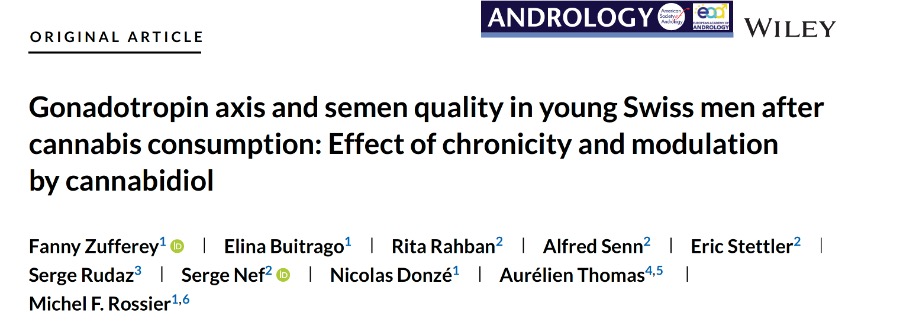
While cannabis is the most widely used recreational drug in the world, the effects of phytocannabinoids on semen parameters and reproductive hormones remain controversial. It is composed of more than 400 chemicals, out of which approximately 100 are cannabinoids. A recent study by Dr. Zufferey and colleagues, published in Andrology, evaluated the impact of the consumption of Δ-9-tetrahydrocannabinol (THC) and cannabidiol (CBD) on semen parameters, as well as on male reproductive hormone and endocannabinoid levels, in a cohort of young Swiss men.
Cannabinoid receptors are activated by these compounds at each level of the hypothalamus–pituitary–gonadotropic axis. The effect of cannabis consumption on LH and testosterone levels in men remains very controversial in the literature. Some studies have reported that chronic marijuana smoking decreases the pituitary production of (luteinising hormone) LH and the production of testosterone by Leydig cells, resulting in a reduction in sperm concentration and motility. On the other hand, some studies report the absence of significant differences in LH or testosterone levels or even describe increased LH and testosterone concentrations.
Dr. Zufferey and colleagues observed that volunteers whose last cannabis consumption was estimated to be within 24 hours before sampling had higher LH concentrations than the control group, but no difference was observed in FSH levels in the same individuals. In contrast, FSH levels appeared significantly increased in CBD-positive users. Also, prolactin levels were lower in cannabis consumers, especially in recent and chronic users.
Their observation of increased testosterone levels in cannabis users was consistent with the results of several previous studies. The higher levels of the testosterone precursor androstenedione, which is significantly elevated in all consumer subgroups, as compared to the lower increased levels of DHEAS limited to chronic users, suggests that the testosterone increase is primarily because of the stimulation of testis steroidogenesis. Also, one possible explanation of increased testosterone levels is that the volunteers in the cohort were relatively young (median age of 19 years), and, as suggested by Thistle et al., the effect of cannabis on testosterone secretion is more pronounced in young men, probably because of the aging of Leydig cells and the natural reduction in testosterone secretion in the older male population.
The results of this study show that the percentage of spermatozoa with progressive motility was slightly higher in the consumer group, particularly in CBD-positive individuals. But after they corrected those results with the difference in abstinence duration between groups, they no longer observed any significant difference between semen from the control group and from the cannabis user group, even when comparing within the various user subgroups. This led to the conclusion that the differences initially observed in sperm parameters were probably not because of cannabis use but rather to a shorter period of abstinence among users.
Overall, these observations did not prove that phytocannabinoids have either adverse or beneficial effects on human semen quality or on hormone levels, which, despite the differences highlighted between the groups, remained within normal physiological ranges. As the authors clearly stated, this work is the first study examining the relationship between phytocannabinoids, specifically CBD, and concentrations of ECBs and hormones, as well as sperm parameters, in a cohort of young men. Because both CBD and THC are frequently used by many men of reproductive age, it is highly relevant to elucidate the potential short- and long-term effects they may have on human reproductive health. For more information, readers are advised to follow up the study on DOI: 10.1111/andr.13440.
